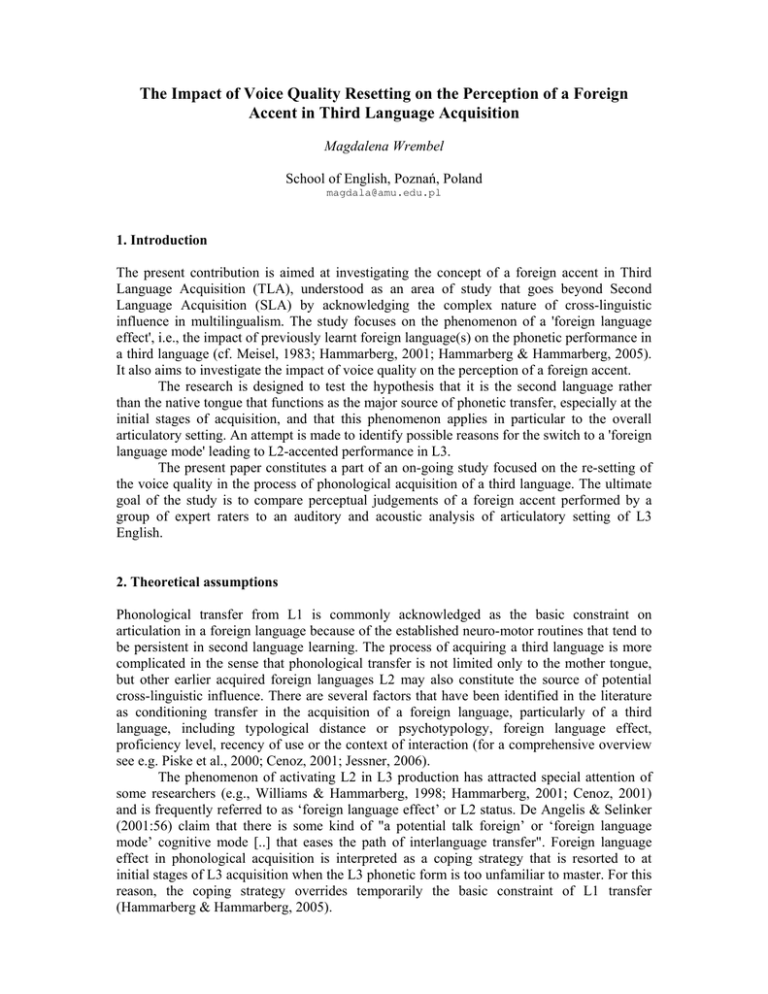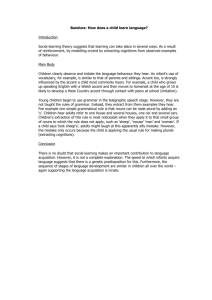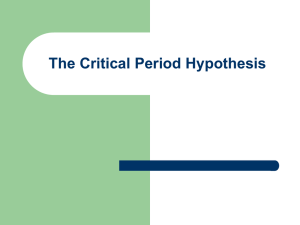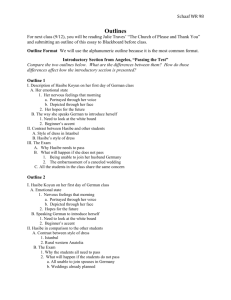The Impact of Voice Quality Resetting on the Perception of a Foreign
advertisement

The Impact of Voice Quality Resetting on the Perception of a Foreign Accent in Third Language Acquisition Magdalena Wrembel School of English, Poznań, Poland magdala@amu.edu.pl 1. Introduction The present contribution is aimed at investigating the concept of a foreign accent in Third Language Acquisition (TLA), understood as an area of study that goes beyond Second Language Acquisition (SLA) by acknowledging the complex nature of cross-linguistic influence in multilingualism. The study focuses on the phenomenon of a 'foreign language effect', i.e., the impact of previously learnt foreign language(s) on the phonetic performance in a third language (cf. Meisel, 1983; Hammarberg, 2001; Hammarberg & Hammarberg, 2005). It also aims to investigate the impact of voice quality on the perception of a foreign accent. The research is designed to test the hypothesis that it is the second language rather than the native tongue that functions as the major source of phonetic transfer, especially at the initial stages of acquisition, and that this phenomenon applies in particular to the overall articulatory setting. An attempt is made to identify possible reasons for the switch to a 'foreign language mode' leading to L2-accented performance in L3. The present paper constitutes a part of an on-going study focused on the re-setting of the voice quality in the process of phonological acquisition of a third language. The ultimate goal of the study is to compare perceptual judgements of a foreign accent performed by a group of expert raters to an auditory and acoustic analysis of articulatory setting of L3 English. 2. Theoretical assumptions Phonological transfer from L1 is commonly acknowledged as the basic constraint on articulation in a foreign language because of the established neuro-motor routines that tend to be persistent in second language learning. The process of acquiring a third language is more complicated in the sense that phonological transfer is not limited only to the mother tongue, but other earlier acquired foreign languages L2 may also constitute the source of potential cross-linguistic influence. There are several factors that have been identified in the literature as conditioning transfer in the acquisition of a foreign language, particularly of a third language, including typological distance or psychotypology, foreign language effect, proficiency level, recency of use or the context of interaction (for a comprehensive overview see e.g. Piske et al., 2000; Cenoz, 2001; Jessner, 2006). The phenomenon of activating L2 in L3 production has attracted special attention of some researchers (e.g., Williams & Hammarberg, 1998; Hammarberg, 2001; Cenoz, 2001) and is frequently referred to as ‘foreign language effect’ or L2 status. De Angelis & Selinker (2001:56) claim that there is some kind of "a potential talk foreign’ or ‘foreign language mode’ cognitive mode [..] that eases the path of interlanguage transfer". Foreign language effect in phonological acquisition is interpreted as a coping strategy that is resorted to at initial stages of L3 acquisition when the L3 phonetic form is too unfamiliar to master. For this reason, the coping strategy overrides temporarily the basic constraint of L1 transfer (Hammarberg & Hammarberg, 2005). The reasons for this switch to a foreign language mode are hypothesised to be of a twofold nature. Firstly, the literature highlights different acquisition mechanisms of the mother tongue as opposed to any foreign language, i.e., the process of learning a second or third language usually takes a similar route of acquisition which is inherently different from the natural acquisition of L1. Therefore, L3 phonological learning may lead to the reactivation of L2 acquisition mechanisms. Secondly, several psycho-affective factors are at play in the process, attitude being one of the most powerful ones. Hammarberg's informant, for instance, reported a strong desire to suppress L1 as ‘non-foreign’ and to use instead a ‘foreign language strategy’ in order to acquire L3. Consequently, we have an interplay of two processes of suppressing L1 and activating L2 that may result in a tendency to rely on the second language as an external source of cross-linguistic influence. Empirical evidence of L2 dominance in L3 phonological acquisition has so far been mostly anecdotal and limited in scope. To the best of my knowledge, the only documented research findings to date come from a longitudinal case study of multilingual Sarah Williams and report on the informant's reliance on L2 articulatory settings that coloured her L3 pronunciation in a global way (Hammarberg & Hammarberg, 1993, 2005). This prompted the present author to embark on a more comprehensive investigation into the nature of third language phonological acquisition. 3. Study 1: Foreign accent ratings The paper reports on two studies conducted on a collected corpus of non-native English speech. Firstly, selected speech samples of L3 English were subject to foreign accent ratings performed by expert judges. Secondly, an acoustic analysis of phonatory resettings in L3 English was performed using fundamental frequency distribution analysis to investigate mean F0 frequency and a global pitch range distribution. The goal was to verify if the values characteristic for the participants' L3 English approximated more those typical for their L2 German or their mother tongue, i.e., Polish. 3.1 Research design The first study was based on a small corpus of non-native English speech collected by the author. The corpus consisted of 240 recordings and had a total length of 6.5 hours. The stimuli were recorded using CoolEdit96 as 16-bit mono files at 16 000Hz sampling frequency. The participants of the study included 60 Polish native speakers with a very good command of German as their L2, and with a rather limited competence in English, which was their L3. Moreover, there were 6 native speakers of German acting as controls, for whom English was an L2 or L3. The participants included Polish students of German philology at Adam Mickiewicz University, Poznań, Poland, who have been learning English at an elementary level as well as students of Applied Linguistics of the same university with a more proficient command of English as their third language. They were assigned to appropriate proficiency levels (i.e., beginner, elementary, pre-intermediate, intermediate) on the basis of a placement test that had been administered at the beginning of the term by their English teachers. The subjects were recorded performing language tasks in 4 conditions: reading a word list, reading a text, telling a picture story and presenting a spontaneous speech. _____________________ New Sounds 2007: Proceedings of the Fifth International Symposium on the Acquisition of Second Language Speech - 482 - 3.2 Accent ratings Foreign accent ratings were performed by expert judges (N=27) who consisted of 7 native speakers of English (NS) and 20 non-native speakers of English (NNS) with a near-native proficiency, all of whom were university lecturers. The author decided to include proficient non-native judges although it is generally claimed that native speakers (NS) are naturally better at detecting a foreign accent. However, this assumption has recently been called into question by some researchers. Højen (2000), for instance, found evidence that non-native speakers are more sensitive to divergences from the target language phonetic norms than the natives, provided they have a distinct mental representation of the authentic pronunciation of L2 sounds. Højen's claim is based on the perceptual magnet effect (cf. Kuhl & Iverson, 1995) stating that non-natives are less sensitive to subcategorial phonetic differences between sounds close to a native phonetic prototype. As far as the judges' EFL teaching experience is concerned, the native speakers had a mean of 10.6 years and for the non-natives, the mean was 7.65 years. All the NNS had some phonetic training, whereas the NS did not. For the accent judgement task thirty speech samples of L3 English were randomly selected from the recorded corpus for this experiment. These were 40-50 s excerpts extracted from the original recordings and included 2 styles: a reading text and free speech. The expert judges were presented with the randomised samples and asked to perform the following tasks: 1) rate the samples for an overall degree of a foreign accent on a 6-point scale (1- heavy accent, 6- native-like) 2) identify the native tongue of the speakers (i.e., select their nationality from an open list presented in the rating questionnaire) 3) point to the phonetic/phonological features that contribute to the perceptual impression of the foreign accent in particular speakers. 3.3 Hypotheses The following hypotheses were put forward: H1: During L3 English performance the Polish speakers with L2 German will tend to be identified as German speakers. H2: Correct identification will be correlated with the speakers' level of proficiency in L3. H3: Higher proficiency level subjects will tend to be identified correctly as Poles. H4: Accent judgements will be correlated to L3 proficiency levels. H5: There may be differences in accent judgements due to interrater variability. 3.4 Results The results of a statistical analysis conducted using the SPSS package shall be presented and discussed in the respective categories. 3.4.1 Correct identification If we look first at the correct identification (i.e., Polish speakers of English identified as Poles, German controls as German), there seems to be no relationship between the correct identification and the speaker's nationality (chi2=0.081, p=0.775). The Polish and German speakers were identified correctly by the raters in 33% and 40% of the cases respectively. As far as correct identification vs. language proficiency is concerned, there was a visible pattern of interrelationship (Pearson chi2= 8.893, p=0.031). The subjects at a higher proficiency level in English (i.e., intermediate and pre-intermediate) were more frequently _____________________ New Sounds 2007: Proceedings of the Fifth International Symposium on the Acquisition of Second Language Speech - 483 - identified correctly as Poles speaking English than those Poles with a lower L3 English proficiency (see Figure 1). Figure 1. Correct identification as Polish vs. language proficiency 3.4.2 Accent judgement vs. proficiency level The variance analysis 1-way ANOVA demonstrated that there is a statistically significant correlation between the proficiency level and mean points assigned for foreign accent (F=55, p<.001). On a 6-point scale, the beginner and elementary level subjects received mean ratings M= 1.75 (in a range 1.3 - 2.1), whereas the mean score for intermediate level subjects was M=3.85 (range 3.0 - 4.3) - see Figure 2. Figure 2. Mean points assigned for foreign accent at particular proficiency levels The relation between correct identification and accent judgement was measured by means of a T-test for Independent Samples (t=-3.75, p<0.000), which pointed to a statistically significant difference between correct identification as a Polish speaker of English and mean points assigned for accent. The subjects who were assigned higher scores for accent were more frequently identified correctly as Polish speakers of English than those whose L3 English performance was judged as being more accented (correct identification - mean score for accent M=2.94; incorrect identification M=2.55). If we now analyse the identification as German vs. correct identification at respective proficiency levels, it appears that beginner and elementary Polish speakers of English were identified incorrectly as German in 53% of the cases, whereas at the intermediate level only in 17%. The reverse was also true for correct identification as the lower level subjects were identified by the raters as Polish learners of English in 24% of the cases, while the more advanced students in 58% (see Figure 3). The results of 1-way ANOVA demonstrated a significant correlation between the identification as German and proficiency level and accent judgement (F=155, p<.001). _____________________ New Sounds 2007: Proceedings of the Fifth International Symposium on the Acquisition of Second Language Speech - 484 - Moreover, the Games-Howell test for multiple comparisons pointed to statistically significant differences between intermediate and beginner/elementary groups at the significance level p<.001. beginner/elementary level intermediate level Figure 3. Identification as German vs. correct identification as Polish at respective proficiency levels 3.4.3 Styles of performance: Reading vs. speaking The scores for accent judgements were then compared with regard to different styles of oral performance, since the samples selected for this experiment included 9 subjects, with both speaking and reading performance in L3 English (5 beginner/elementary and 4 intermediate). It turned out that the accent ratings for these subjects were consistent with respect to the proficiency levels. The beginner/elementary subjects remained in the 1.4-2.0 range (on a 6point scale, 1- strongly accented, 6 - near-native like), and the points assigned to each individual for speaking were on average 0.5 point lower than for reading. As far as the intermediate subjects are concerned, their ratings were in the 3.7-4.3 range and their individual scores for speaking were on average 0.4 point higher than for the reading mode. Stronger L2-accent in speakin beginner/elementary level intermediate level Figure 4. Correct identification as Polish vs. German identification at respective levels Figure 4 illustrates the patterns of identification in the reading and speaking mode of performance for the two proficiency levels. As can be seen, the lower level Polish subjects performing in L3 English were incorrectly identified as German in 37% of the cases when _____________________ New Sounds 2007: Proceedings of the Fifth International Symposium on the Acquisition of Second Language Speech - 485 - they read a text, however, this number increased to 60.6% in the speaking mode. A similar tendency was evidenced for the higher proficiency level subjects, yet the percentage of incorrect identification was significantly lower. In the reading mode they were labelled as German only in 12% of the cases, whereas in speaking the percentage increased to 40.7%. Interestingly enough there were no such significant discrepancies between the performance modes when we analyse the subjects' being correctly identified by the raters as Polish speakers. The differences in this case were negligible and equalled 1% for the lower group and 4% for the intermediate one. 3.4.4 Raters' variables As far as raters’ variables are concerned, the T-test analysis showed differences between native and non-native speaker judgements (t=4.3, p<.001). The non-native judges assign lower points for accent and tend to be more severe than English native speakers. However, there was no correlation between the type of judges (native vs. non-native) and the correct identification (chi2=1.285, p=0.2), which means that the Polish judges' ability to identify the speakers correctly did not differ significantly from that of the native English speakers. Furthermore, no correlation was found between the judges' experience measured in the length of teaching and their scores in the accent judgements. 3.5 Study 1: Conclusions It was found that the scores for foreign accent ratings assigned by the judges reflected the speakers' actual command of L3 English as the ratings corresponded to their respective proficiency levels, i.e., elementary and beginner learners received significantly lower scores than intermediate learners. This finding pointed to the reliability of foreign accent ratings, which reflected to a considerable extent the subjects' group assignment that had been based on a proficiency test. It was only the pre-intermediate group that did not quite follow this pattern as its scores fell in the lower level category rather than closer to the upper band as could have been expected. However, this proficiency level was fairly underrepresented (N=2), which might have affected the results. An interesting regularity was observed in case of the correct identification of the speaker's nationality. There was a visible tendency for higher proficiency level subjects to be identified correctly as Poles, whereas lower proficiency levels (i.e., beginners and elementary learners of L3 English) tended to be labelled more frequently as German. This finding provides further evidence for Hammarberg & Hammarberg's (2005) claim that it is the second language rather than the mother tongue that constitutes a stronger source of cross-linguistic transfer at the initial stages of phonological acquisition thus leading to L2-accented speech in L3 performance. Furthermore, the results of accent judgements were fairly consistent with regard to the performance modes, i.e., individual subjects received comparable proficiency judgements irrespective of the fact whether their performance involved reading or speaking. The average differences in accent ratings for a given mode were fairly negligible. Furthermore, similar tendencies were observed in the pattern of correct and incorrect recognitions of the subjects' nationality on the basis of their speech samples. The subjects' L3 English was perceived as more L2-accented in the speaking mode than in reading both in the lower and upper level groups, however, the numbers were relatively higher in the former case. This may lead to a tentative conclusion that the spoken mode is more susceptible to a stronger phonological transfer from L2. On the contrary, no such tendency was reported when the subjects' performance was labelled as L1-accented, as the percentages of correct identification were similar notwithstanding the mode at both levels respectively. _____________________ New Sounds 2007: Proceedings of the Fifth International Symposium on the Acquisition of Second Language Speech - 486 - As expected, the raters’ variables were found to have some bearing on accent judgements. A visible discrepancy was observed between the ratings by native speakers and non-natives. The latter were more severe and assigned lower scores for accentedness, which seems consistent with some previous results of research on foreign accent (cf. e.g. Scheuer, 2000). However, the fact that the judges were native or non-native did not have any significant impact on their correct identification of the subjects, i.e., NS and NNS performed equally well in this respect. This adds further support to the decision to include non-native proficient speakers as expert raters performing accent judgement tasks. In conclusion, all the hypotheses formulated in 3.3 on the basis of the literature on Third Language Acquisition and previous limited research findings were mostly corroborated by the present results. The claim that during L3 English performance the Polish speakers with strong L2 German will tend to be identified as German speakers was found to be true for lower level proficiency learners (elementary and beginners), however, it did not hold for more advanced learners of English. This meant that the tendency to be identified correctly as Poles was correlated with the speakers' level of proficiency in L3 and a higher percentage of correct identification was observed at the intermediate level. Moreover, also accent judgements were correlated with the subjects' L3 proficiency levels, i.e., lower level subjects received significantly lower ratings than their more proficient counterparts. As expected there were some discrepancies in accent judgements due to interrater variability. Nonetheless, Study 1 provided further evidence for L2-accented performance in a third language, however, it was restricted to the above discussed conditions. 4. Voice quality resetting A question arises what are the features that influence the perception of a foreign accent. It is commonly acknowledged that cross-linguistic phonetic influence is not restricted to segmental and suprasegmental aspects but it also relates to a general articulatory setting or ‘voice quality’, i.e., a long-term articulatory posture or an overall sound quality that provides an auditory colouring of a given language (cf. Honikman, 1964; Laver, 1980; Jenner, 1995). It refers to characteristic features of this language such as pitch level, vowel space, neutral tongue position and the degree of muscular activity. These features are common to speakers of a given target variety and result from using organs of articulation in a particular way. The question whether the acquisition of a new foreign language involves the re-setting of the voice quality has sparked some interest among researchers, however, the generated results were fairly inconclusive (see e.g. Hammarberg & Hammarberg, 2005). There seem to be several related research questions that need to be addressed: 1) To which extent the general articulatory setting contributes to the perception of a foreign accent? 2) Which articulatory settings are adopted in early L3 production, those of L1 or L2? 3) Does the articulatory resetting in L3 actually take place? 4.1 Study 2: Research design The second study consisted in an acoustic analysis of phonatory resettings in L3 English that involved a fundamental frequency distribution analysis, i.e., mean f0 frequency and pitch range. Twenty recordings were randomly selected from the original corpus of L3 English. The subjects were identified and recorded in another session performing in their L2 German and L1 Polish. Only a reading mode was selected for the purpose of an investigation in Study 2. The stimuli were recorded using CoolEdit96 as 16-bit mono files at 16 000Hz sampling _____________________ New Sounds 2007: Proceedings of the Fifth International Symposium on the Acquisition of Second Language Speech - 487 - frequency. Three 5s extracts were selected from each language sample (i.e., English, German and Polish) for the analysis. The acoustic measurements were performed in WaveSurfer 1.8.5. 4.2 Results The statistical analysis of acoustic measurements was performed using SPSS. The results of the Paired Samples T-test pointed to significant differences in the mean pitch between L2 German and L3 English samples (t=2.82, p=.01). The mean values of f0 for the subjects performing in the respective languages were as follows: German - mean f0= 235 Hz English - mean f0= 225 Hz Polish - mean f0= 230 Hz. A linear regression analysis that was performed pointed to the fact that the dependant variable, i.e., the L3 English mean f0 is affected by the L2 German mean pitch (see Table 1). Table 1. Linear regression analysis - mean pitch Model Summary Model 1 R R Square Adjusted Square ,680(a) 0,462 0,395 R Std. Error of the Estimate 15,10975 a. Predictors: (Constant), GER_Mean_Pitch, POL_Mean_Pitch Coefficients(a) (Constant) Model 1 Unstandardized Coefficients Standardized Coefficients B Std. Error Beta 1,051 65,191 t Sig. 0,016 0,987 POL_Mean_Pitch 0,375 0,331 0,260 1,132 0,275 GER_Mean_Pitch 0,655 0,306 0,491 2,138 0,048 a. Dependent Variable: ENG_Mean_Pitch The R square value indicated that 46% of variability of the dependent variable (ENG Mean Pitch) can be explained by means of an independent variable (GER Mean Pitch). A graphic display of the relationship between the control parameter (German mean pitch) and the dependent variable is presented by means of a scatter plot (see Figure 5). The slope illustrates a fairly positive correlation between the variables being studied. Figure 5. Scatter Plot – German vs. English Mean Pitch _____________________ New Sounds 2007: Proceedings of the Fifth International Symposium on the Acquisition of Second Language Speech - 488 - As far as the results of the pitch range statistical analysis are concerned, the Paired Samples T-test showed no statistically significant differences between the pitch range of Polish vs. English, Polish vs. German, German vs. English. However, the linear regression analysis demonstrated a significant association between the German and the English pitch range (see Table 2). Table 2. Linear regression analysis - pitch range Coefficients(a) Model 1 Unstandardized Coefficients Standardized Coefficients Beta B Std. Error (Constant) 63,884 32,186 POL_Range 0,081 0,193 GER_Range 0,476 0,188 R R Square Adjusted Square ,610(a) 0,373 0,294 t Sig. 1,985 0,065 0,093 0,420 0,680 0,563 2,534 0,022 Model Summary Model 1 R Std. Error of the Estimate 27,25044 a. Predictors: (Constant), GER_Range, POL_Range The scatter plot in Figure 6 illustrates the association between the dependent variable (L3 English pitch range) and the independent variable (L2 German pitch range) that affects the former. A positive correlation is manifested by the non-random distribution of the plotted data. Figure 6. Scatter plot - German vs. English pitch range Recapitulating, the fundamental frequency distribution analysis points to the fact that the dependant variable L3 English is affected by L2 German rather than L1 Polish, and that the correlation is rather strong both in the case of mean f0 frequency and the pitch range. All in all, the present findings corroborate Hammarberg & Hammarberg’s (1993, 2005) results concerning the dominating effect of L2 on L3 phonological acquisition. The partial reliance on L2 phonetic encoding at early stages of phonological acquisition seems to be a coping strategy that outweighs the transfer from L1. Although L2-accented speech _____________________ New Sounds 2007: Proceedings of the Fifth International Symposium on the Acquisition of Second Language Speech - 489 - prevails at the initial stages of TLA, it diminishes with the increase in L3 proficiency and gradual approximation of the target norm. Taking into account the complexity of Third Language Acquisition one cannot ascribe the whole cross-linguistic influence to one factor only, in this case the L2 status. The results of the presented studies are most likely a cumulative effect of several variables including the L2 status (i.e., foreign language effect); psychotypology (English and German being Germanic languages, one may expect more cross-linguistic influence from German than from Polish) as well as the recency and intensity of use of L2 German by the subjects involved in the experiments. 5. Directions for future research Future research will involve a further auditory and acoustic analysis of contrastive articulatory settings in Third Language Acquisition (i.e., L3 vs. L1 and L3 vs. L2, possibly also L2 vs. L1) as Study 2 constituted only a preliminary attempt to investigate this field. To the best of my knowledge, the existing accounts of contrastive settings of the languages in question include Kelz (1971) for English vs. German, and Święcinski (2004) for English vs. Polish. The present author's ultimate goal is to provide a more comprehensive account of the contrastive articulatory settings of Polish, German and English in order to explore the sources of cross-linguistic influence in the process of articulatory resetting in L3 phonological acquisition. Apart from a detailed impressionistic auditory analysis, I would like to resort to some of the more objective means of investigating different aspects of articulatory setting as reported in the literature (for a comprehensive classification see Laver, 1980). The analysis is going to focus on selected aspects including phonatory, lingual and labial settings as well as the overall muscular tension. Some of these dimensions are fairly impressionistic and hard to measure like muscular tension or laryngeal settings although, for instance, video can be used to record upwards or downwards movements of the larynx (cf. Święcinski, 2004). A similar strategy can be applied to the labial setting analysis to study the cross-section and range of lip movements characteristic of a particular language. The general lingual setting may, in turn, be investigated by calculating the mean formant values for all vowels of a language, a method suggested by Laver (1980). Finally, the type of phonation may be established by comparing the intensity of the first two harmonics or by using the inverse filtering method. To conclude, phonological acquisition of a third language is still in its infancy and more comprehensive studies are necessary to throw light on this emerging field. References Cenoz, J. (2001). The effect of linguistic distance, L2 status and age on cross-linguistic influence in third language acquisition. In J. Cenoz, B. Hufeisen, & U. Jessner (Eds.), Cross-linguistic influence in third language acquisition: Psycholinguistic perspectives (pp. 8-20). Clevedon: Multilingual Matters. De Angelis, G., & Selinker, L. (2001). Interlanguage transfer and competing linguistic systems. In J. Cenoz, B. Hufeisen, & U. Jessner (Eds.), Cross-linguistic influence in third language acquisition: Psycholinguistic perspectives (pp. 42-58). Clevedon: Multilingual Matters,. Hammarberg, B. & Hammarberg, B. (1993). Articulatory re-setting in the acquisition of new languages. Phonum, 2, 61-67. Hammarberg, B., Hammarberg, B. (2005). Re-setting the basis of articulation in the acquisition of new languages: A third-language case study. In B. Hufeisen, & R. Fouser (Eds.), Introductory readings in L3. Tübingen: StauFFenburg Verlag. _____________________ New Sounds 2007: Proceedings of the Fifth International Symposium on the Acquisition of Second Language Speech - 490 - Hammarberg, B. (2001). Roles of L1 and L2 in L3 production and acquisition. In J. Cenoz, B. Hufeisen, & U. Jessner (Eds.), Cross-linguistic influence in third language acquisition: Psycholinguistic perspectives (pp. 21-41). Clevedon: Multilingual Matters,. Højen, A. D. (2000). Detection of Danish accent in English by native speakers of Danish. In A. James, & J. Leather (Eds.), New Sounds 2000: Proceedings of the Fourth International Symposium on the Acquisition of Second-Language Speech (pp. 80-86). Klagenfurt: University of Klagenfurt. Honikman, B. (1964). Articulatory settings. In D. Abercrombie et al. (Eds.), In honour of Daniel Jones (pp. 73-84). London: Longman. Jenner, B. (1995). The English voice. In A. Brown (Ed.), Approaches to pronunciation teaching (pp. 38-46). Hemel Hempstead: Prentice Hall International. Jessner, U. (2006). Linguistic awareness in multilinguals. English as a third Language. Edinburgh: Edinburgh University Press. Kelz, H. P. (1971). Articulatory basis and second language teaching, Phonetica, 24, 193-211. Kuhl, P., & Iverson, P. (1995). Linguistic experience and the 'perceptual magnet effect'. In W. Strange (Ed.), Speech perception and linguistic experience: Theoretical and methodological issues (pp. 121-154). Baltimore: York Press. Laver, J. (1980). The phonetic description of voice quality. Cambridge: Cambridge University Press. Meisel, J. (1983). Transfer as a second language strategy. Language and Communication, 3, 11-46. Piske, T., Flege, J. E., MacKay, I. R. A. (2000). Factors affecting degree of global foreign accent in an L2. In A. James, & J. Leather (Eds.), New Sounds 2000: Proceedings of the Fourth International Symposium on the Acquisition of Second-Language Speech (pp. 290-297). Klagenfurt: University of Klagenfurt. Scheuer, S. (2000). What makes foreign accent sound foreign? A. James, & J. Leather (Eds.), New Sounds 2000: Proceedings of the Fourth International Symposium on the Acquisition of SecondLanguage Speech (pp. 306-314). Klagenfurt: University of Klagenfurt. Święciński, R. (2004). Articulatory setting in Polish and its implications for teaching English pronunciation to Poles. In W. Sobkowiak, & E. Waniek-Klimczak (Eds.), Materialy konferencyjne Dydaktyka fonetyki jezyka obcego w Polsce [Proceedings of a Conference on the teaching of foreign language phonetics]. Konin: Wydawnictwo PWSZ w Koninie. Williams, S., & Hammarberg, B. (1998). Language switches in L3 production: Implications for a polyglot speaking model. Applied Linguistics, 19, 295-333. _____________________ New Sounds 2007: Proceedings of the Fifth International Symposium on the Acquisition of Second Language Speech - 491 -



